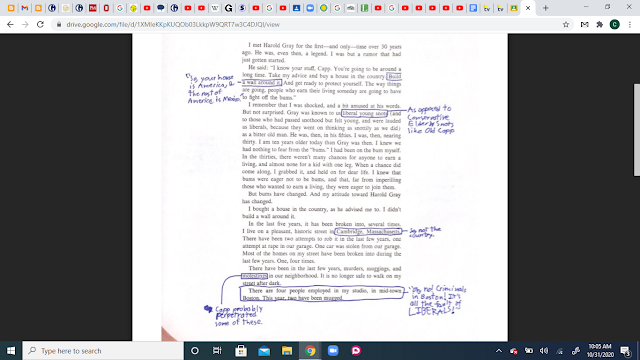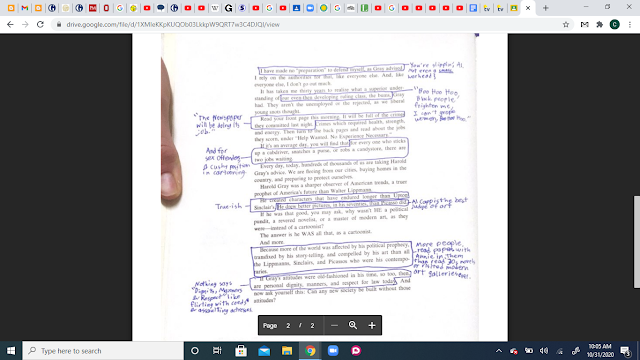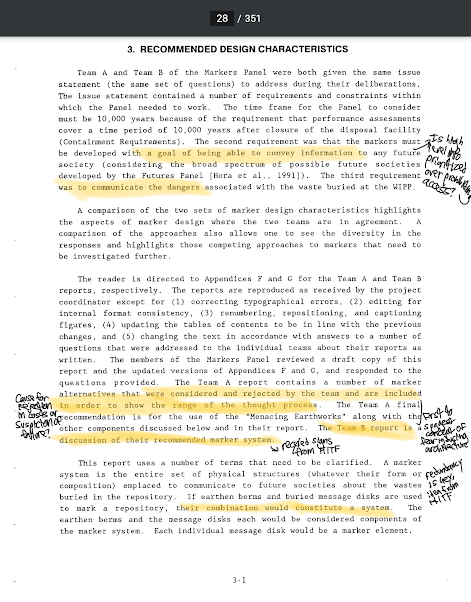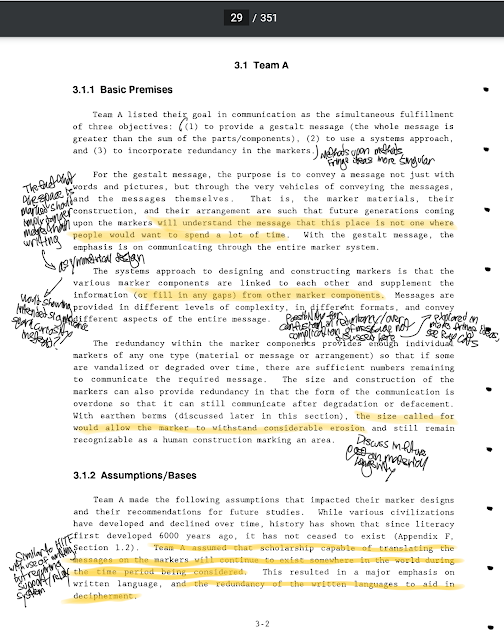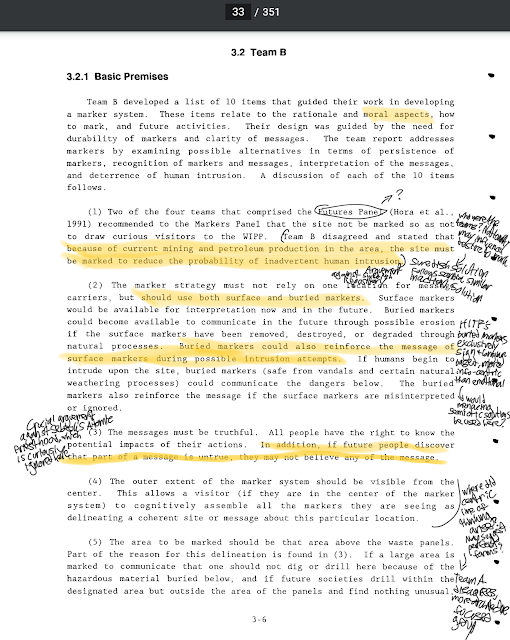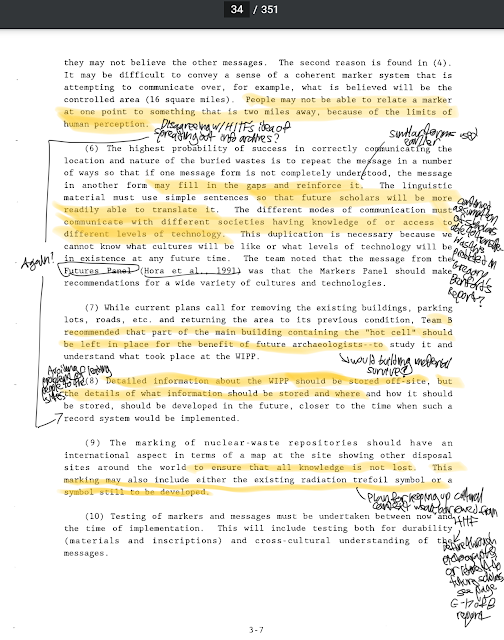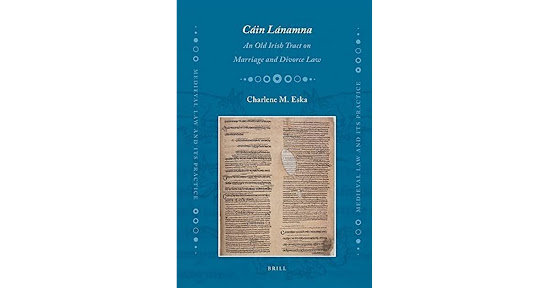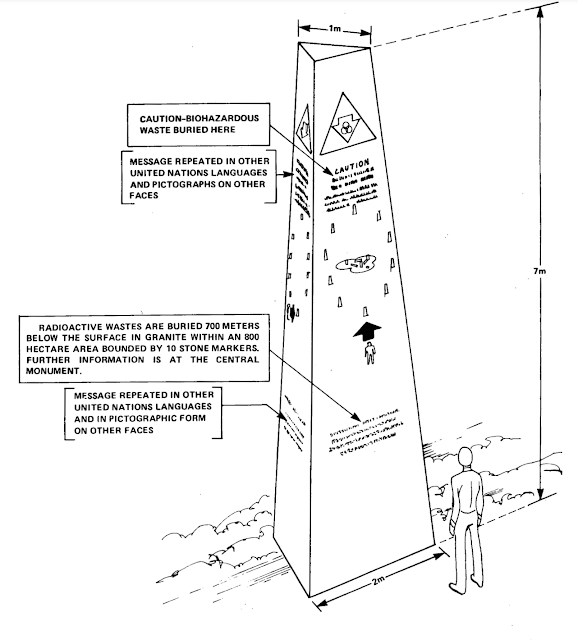This blog is primarily a resource for the class "Becoming a Bookmaster, Step 1: Bibliography as Research" at Community High School of Arts & Academics, Roanoke VA.
Saturday, October 31, 2020
Friday, October 30, 2020
This Place is Not a Place of Honor: Sandia Report Marginalia
The text is from one of the two major US Department of Energy reports for creating long term nuclear waste warning messages, specifically the report from 1993 for the Waste Isolation Pilot Plant by Sandia National Laboratories. I annotated onto screenshots of the pages rather than on paper, since it's become easier for me to keep track of online sources than physical ones. These pages establish the requirements of any warning message, as presented by two different teams on the WIPP panel, and come relatively early in the report. It's interesting to draw parallels between what the Sandia report deems important and the requirements of earlier efforts in the field of Nuclear Semiotics, and my notes are somewhat about assessing the team's design solutions and comparing them to other proposed markers.
[Status - Brehon] Looking at Marriage Through the Cain Lanamna
Unsurprisingly, same-sex marriage is never written about in legal texts or mythology. The most probable explanation is that it was a cultural 'given' that same sex marriage was unacceptable. It is not unlikely that Christian Monks simply censored it from the texts we have now, in which case we could potentially find hints about it remaining in some mythological stories. The most interesting explanation posits that marriage and romance were separate to some degree, so that there could have been same-sex romance but there was never a need to marry, as marriage was external to the relationship. I will explore the role of marriage in Early Irish society in this post - but keep posted, because the next post will be about same-sex relationships and transgender themes in Irish and general Celtic mythology and society.
The Cain Lanamna dates to around 700AD. It reads a little like a notebook composed of disjointed notes that need more context to actually make sense. Nonetheless, it gives a lot of very useful information about Early Irish customs. It states the following about the nature of marriage:
"Question: how many couples of cohabitation and procreation are there in Irish law? Answer: ten-(1) union of common contribution; (2) union of a woman on a man's contribution; (3) union of a man on a woman's contribution with service; (4) union of a woman who accepts a man's solicitation; (5) union of a man who visits the woman, without work, without solicitation, without provision, without material contribution; (6) union by abduction; (7) union of wandering mercenaries; (8) union by criminal seduction; (9) union by rape; (10) union of mockery."
- Cain Lanamna, Section 4 (Translated by Donnchadh Ó Corráin)
First, marriage is referred to as a "couple of cohabitation and procreation." This is in-line with the Christian values of the time that pervaded most of Europe's different cultures. Marriage and love were separate: marriage was for procreation, the household economy, social stability, and external perception, whereas strictly love-based relationships were advised against.
This contrasts with the overt presence of polygyny throughout the text. The term cetmuinter is used many times throughout the text. The meaning of this term is debated: some think it means "first wife," as in the wife which possessed the most power or wealth out of all of the man's wives, while other believe it means "head of the household." Whichever interpretation is correct, it was observed by Roman writers that men could in fact marry multiple women.
We see the household economy already brought up in the first five points. Of note is the difference from point 2 to point 3, where the union can happen on a man's contribution, but if it happens on the woman's contribution, she must also provide service. This contrasts with how - apart from the laws about abduction and rape - equal men and women were in marriage, at least in nobility. Unlike in the rest of Europe, a woman could choose to divorce her husband. In doing so, she kept all the property which she had owned before the marriage, all the property which her husband had given her, and a portion of the wealth (here it is "raw materials") according to her "industry," or the lucrativeness of her profession.
When the woman is of lesser social status than the man, then she cannot refuse to marry a man if he offers any contribution that is not "clothing and food; and [...] cattle and sheep." Additionally, a woman who was raped by a man who already had a cetmuinter, she would only be entitled to half of her eraic (the price one had to pay the person/clan/family in the case of murder or rape), as opposed to the entire eraic that cetmuinter were entitled to. Any woman below the status of cetmuinter was also exempt from many of the laws that made divorce fair. They were not entitled to what their husband had contributed for their marriage ("bridewealth"/dowry).
The term "union by rape" is very vague, and it is not clear whether a woman was forced into a marriage if she was raped, or if it is referring to adultery in some regard.
Men had the right to hit their wives without consequence, unless it left a mark, in which case the wife would be entitled to the equivalent to her or her husband's bridewealth, and could also divorce him. Obviously I cannot say it is 'progressive' for men to have the right to hit their wives, but most of Europe did not have this punishment in place for substantial physical abuse at this time.
It seems that as in many other cultures, the law existed in part for social stability. First, any ill behavior from one spouse targeted at the other was punished. "Everything taken by stealth, by force, by secret removal, without consent, without recompense, without asking pardon, is levied with its penalty fine." Any destabilizing behavior or "bad faith" on behalf of any one spouse is condemned throughout the text. Additionally, the last Section sheds the most light on this. It states that in a "Union of Mockery," "The person who brings them (a "lunatic or madman" and a "deranged woman or madwoman") together for fun and the responsible person in whose presence this takes place, theirs is the offspring, if offspring there be; its rearing, compensation for its offences, and its suretyship falls on both of them." First of all, is this really common in Early Irish society? Or what event did those involved with writing this text witness or hear about before writing this? But most important to the topic is the emphasis on the "sane" one raising the child and being responsible for their misdemeanors. We can infer that this law was for the wellbeing of the child, since they would be raised by a parent that was seen as more competent, even though that parent had "[brought the 'madmen' together]," which may imply a lot about the parent's competence to raise a child. But we can also infer that this law was also in place to prevent the havoc that child may cause if they had been raised by 'madmen.' Due to the brevity of the document, there is no elaboration on the terms 'lunatic,' 'madman,' 'deranged woman,' or 'madwoman.' 'Madness' and mental illness will be the topic of a future post.
The disjointed nature of the text points to its purpose, and hence how we should interpret it. The text is not completely comprehensive in its approach; rather, it provides specific rules for a few eventualities that were thought of by those who wrote this at the time that they wrote it. In no way does this exactly represent Irish society. As Laurence Ginnell writes in "Leges Minores": "It is one of many cases in which the law is more concerned with the few who invoke it than with the many who never invoke it during their lives." The law will only cover the eventualities for which it will be needed, not those that can be settled outside of the law, or those that rarely ever occur.
If you take away anything from this post, it should be that women had a unique role in marriage and society. People like to point out that women had equal rights in divorce, and were even sometimes favored, but this is not true for those of lower economic status than their husbands. Men still had the right to hit their wives, and women could still be forced into marriage without consent. I will be posting more on the role of women in nobility and war in a future post.
References
The text itself (Cain Lanamna): https://celt.ucc.ie//published/T102030/index.html
[This is full of inaccurate information and almost seems ironic. Take a look if you want a laugh] Gibson, Gayle. (2005, March 16). Same-sex Celts: Saint Brigid & her special friend. DailyXtra. https://www.dailyxtra.com/same-sex-celts-2-39898
[This one is also riddled with inaccuracies and fun to read] Histor. (2013, September 9). Polygamy & Divorce in ancient Ireland. Irish History blog on Blogger. https://history-ireland.blogspot.com/2013/09/polygamy-divorce-in-ancient-ireland.html
[This one is fairly useful but beware of some of the information] Ojibwa. (2020, Jul 15). Religion 101: Women and marriage under ancient Irish Brehon law. Daily KOS. https://www.dailykos.com/stories/2020/7/15/1960496/-Religion-101-Women-and-marriage-under-ancient-Irish-Brehon-law
Ginnell, Laurence. (1894). Leges Minores. Chapter VIII, from Library Ireland. https://libraryireland.com/Brehon-Laws/Marriage.php
Anon. (some professor at UT Austin probably). (2009). Gender and Sex. Iron Age Celts. https://www.laits.utexas.edu/ironagecelts/sex.php
Wikipedia:
'LGBT themes in mythology'
'Eraic'
American Soccer, from Jamestown to 1900
A Surprisingly Strong Start
Soccer-like games have been played in various places around the world since the golden days of Rome. The United States was the first British colony to play any football-type activity. Some style of pick-up football was played as long ago as 1609, brought to the U.S. by the settlers of Jamestown. The rules of the game are unknown, but the game probably resembled the mob games going on in England around the same time. They were likely some kind of mix between today's rugby and soccer and were probably fairly violent. Unlike the games taking place between towns in England, local leaders in the first American colonies were successful in suppressing these football mob games, and by 1620, had outlawed them effectively for over two centuries.
Pick-up football games surged in America in the late 1820’s, when Northeastern universities like Amherst, Brown, Princeton, and Harvard infused the games into college life. The first written account of association football being played in the U.S. was in 1827, when the freshman and sophomore classes at Harvard instituted an annual football game to take place on the first Monday of every school year. This annual event was evidently quite riotous, earning itself the nickname of “Bloody Monday”. Princeton played something known as “ballown” in which the ball, originally rubber, was hit with the fist along with the foot toward the opposing team's goal. Each school played its own style of football, much like their academic counterparts in England, with some schools, such as Harvard, favoring a dribbling style game and others, like Prineton, opting to handle the ball with their hands. It worked fine for every school to play its own type of football because there was no inter-school competition in the U.S. at this point.
Bloody Monday, 1830
The next major development in American soccer was the founding of the Oneida Boston Soccer Club in 1862, which was only five years after the pioneering official British clubs formed. The Oneida Club consisted of students from some of Boston’s most prestigious secondary institutions, such as Boston Latin and Boston English. The Oneida boys played collegiate level pickup teams, and went both undefeated and unscored upon in their first season; proof that practice and familiarity with one's own team makes all the difference in competition sport. It is unknown whether the Oneitas were playing rugby style or association football, but if they were playing association football, then they would be the first club soccer team to have arisen outside of England, even beating out the oldest Scottish clubs.
Oneida Boys, 1862
College association football hit a wall with the start of the Civil War, but was brought back shortly after in 1866. The game was still not what modern people would call soccer, Princeton, for instance, played the game with 25 people on the field per a team. In 1869, the first intercollegiate game was held between Princeton and Rutgers (Rutgers won 6-4). The teams used London FA’s 1863 rules, which interestingly allowed for the handling of the ball. The rules provided that the first team to score six goals won. This game was also recorded as the first North American modern football game as well.
A conference was held between Princeton, Yale, Columbia, and Rutgers in 1873. The meeting was held because football had become a popular enough college sport that the schools wanted to play one another. This had not been done up to this point because of the hodgepodge of conflicting rules each institution used. The universities agreed upon a set of rules, which differed quite a bit from the European rules of the time. Under the new rules, there would be 20 players per team, who could all carry the ball and the first team to achieve six points would win. This set of rules did not last long, as in 1880 Yale kicked-off against the Eton Players, from England, in the first Anglo-American soccer game ever. The Yale team lost 1-2, and was then persuaded by the Eton team to embrace the London FA rules. Yale went on to quickly and successfully persuade the other American colleges in their conference to adopt the FA rules as well. The soccer that these schools were now playing is the same game that is played across the globe today.
As Yale was busy endorsing London FA rule association football (soccer), Harvard was hard at work building up its rugby program. Both schools were proud of their own success at their game of choice, and keen to prove to the opposition that their school played the right kind of football. Parties from both Yale and Harvard met to set a compromised set of rules. There were to be 15 players per side, the ball could be handled or kicked, and either team could score via shot on goal or touch down. With Princeton students filling the audience, Harvard crushed Yale (4-0). It was such an embarrassing defeat that Yale agreed to switch to Harvard's new style of football, Princeton quickly followed suit. With the three most prominent institutions in the country all signed on to play Harvard's new American football, every other school jumped on the bandwagon. And with that, university american soccer fell into obscurity.
Harvard vs.Yale (4-0)
Recommended Reading for this Post
Litterer, David. “An Overview of American Soccer History.” A Historical Overview of American Soccer History, 21 May 2010, soccerhistoryusa.org/ASHA/overview.html. https://soccerhistoryusa.org/ASHA/overview.html
This is the most complete, well researched short article on the history of American male soccer that I have found. For the first post I am focusing primarily on the first two sections, which covers events from 1619-1880. This reading does spend a lot of time on college sports, but that is a good place to start looking for the history of most globally successful sports.
My second article on this topic will discuss from 1880-1970, which will cover the next six sections of the reading. I will probably sight this text again in the future. I recommend reading as much of it as you like, it isn’t the most captivating read but it is full of a lot of great general knowledge.
This Place is Not a Place of Honor-- Nuclear Semiotics Reading Plan
Nuclear Semiotics Reading Plan
Asterisks indicates currently inaccessible sources
Short-term goals (To read more thoroughly):
Sebeok, Thomas A. “Pandora’s Box: Why and How to Communicate 10,000 Years Into the Future.” Alfred Korzybski Memorial Lecture, 6 November 1981. https://www.generalsemantics.org/wp-content/uploads/2011/04/gsb-49-sebeok.pdf
Jensen, Michael, Nordic Nuclear Safety Research. Conservation and Retrieval
of Information- Elements of a Strategy to Inform Future Societies about Nuclear Waste Repositories. Roskilde, Denmark, 1993.
Givens, David B. “From Here To Eternity: Communicating with the Distant Future.” A Review of General Semantics, vol. 39, no. 2, 1982, pp. 159–179. https://www.jstor.org/stable/42575926
Munsch, Sebastian. “The Atomic Priesthood and Nuclear Waste Management - Religion, Sci-fi, Literature, and the End of our Civilization.” Zygon Journal of Religion and Science, vol. 51, no. 3, 2016, pp. 626-639. https://www.academia.edu/27875581/The_Atomic_Priesthood_and_Nuclear_Waste_Management_Religion_Sci_fi_Literature_and_the_End_of_our_Civilization_in_Zygon_Journal_of_Religion_and_Science_Volume_51_Issue_3_2016_p_626_639
Sebeok, Thomas A. United States, US Department of Energy, Research Center for Language and Semiotic Studies. Communication Measures to Bridge Ten Millennia. Columbus, Ohio, Government Printing Office, 1984.
https://inis.iaea.org/collection/NCLCollectionStore/_Public/16/010/16010244.pdf
Risk assessment of Sweden’s repository
https://www.researchgate.net/publication/252675003_Nuclear_Waste_Risks_and_Sustainable_Development
Trauth, Kathleen, et al. United States, Department of Energy, Sandia National Laboratories. Expert Judgment on Markers to Deter Inadvertent Human Intrusion into the Waste Isolation Pilot Plant. Albuquerque, New Mexico, Government Printing Office, 1993. https://prod-ng.sandia.gov/techlib-noauth/access-control.cgi/1992/921382.pdf
United States, Department of Energy, Office of Nuclear Waste Isolation. Reducing the Likelihood of Future Human Activities That Could Affect Geologic High-level Waste Repositories. Columbus, Ohio, Government Printing Office, 1984.https://www.osti.gov/servlets/purl/6799619
5-page WIPP report on passive institutional control requirements
https://www.osti.gov/servlets/purl/1242770
Pierce, Sebeok, and the Semiotic Reformation on Contemporary Communications
http://www.gilsonsociety.com/files/011-031-Magsino.pdf
Paper on Biolinguistics and Biosemiotics, goes into Sebeoks work
https://biolinguistics.eu/index.php/biolinguistics/article/view/255
Gregory Benford and a few others’ WIPP official doc contributions. This would be very helpful for sections on predicting what the future holds. Includes 3 scenarios of technological advancement/regression
https://inis.iaea.org/collection/NCLCollectionStore/_Public/22/064/22064107.pdf
Thomas Sebeok’s review of his own submitted report to HITF, a part of the Topics in Contemporary Semiotics Book series, perhaps I could find other sources there
https://link.springer.com/chapter/10.1007/978-1-4899-3490-1_13 *
Mid-term goals (To read in the next two years):
Ghertner, D. Asher, et al. “Security Aesthetics of and Beyond the Biopolitical.” Futureproof:
Security Aesthetics and the Management of Life. Durham, NC, Duke university Press, 2020. https://read.dukeupress.edu/books/book/2698/chapter/1965540/Security-Aesthetics-of-and-Beyond-the-Biopolitical
Gregory Benford (sci fi author on WIPP panel)’s first hand account of working to come up with these solutions, which he calls Deep Time. Gives good insight into their thought process, as well as what it was like to work on this team
https://www.physics.uci.edu/~silverma/benford.html *
Environmental Impact Statement for Yucca Mtn depository
https://www.nrc.gov/docs/ML0326/ML032691306.pdf
EPA on institutional controls
https://www.epa.gov/sites/production/files/documents/final_pime_guidance_december_2012.pdf
2004 Waste Isolation Pilot Plant Implementation Plan
https://www.wipp.energy.gov/library/PermanentMarkersImplementationPlan.pdf
Handbook of semiotics, less specific more general usage in modern society
Into Eternity (2010) documentary
Long-term goals (To read in the next five years):
Circles in architecture as the perfect form
https://archive.bridgesmathart.org/1999/bridges1999-173.pdf
Semiotics for Beginners David Chandler pdf
https://postarchive.files.wordpress.com/2015/03/semiotics-for-beginners.pdf
Using the Past to Protect the Future, by Maureen F. Kaplan and Mel Adams, Archeology, Sept. 1986, pp. 51-54. *
A complete, 218 page history of the Waste Isolation Pilot Plant project, this gives history to the creation of the plant and the problem at hand. Not focused on scientific nitty gritties or solutions, more on the context for these ideas
https://www.sandia.gov/about/history/_assets/documents/MoraWIPP991482.pdf
Directory Sources (Sources with useful bibliographies and links):
Dunn, Charles. Multigenerational Warning Signs. March 17, 2011. http://large.stanford.edu/courses/2011/ph241/dunn2/ (General, Trefoil)
Forum site with good sources and overview, but it’s really sketchy
http://www.nuclear-heritage.net/index.php/Marking_Nuclear_Waste_Disposal_Facilities(General, Nuclear energy today)
Tannanbaum, Percy H. United States, Department of Energy, Office of Nuclear Waste Isolation. Communication Across 300 Generations: Deterring Human Interference with Waste Disposal Sites. Columbus, Ohio, Government Printing Office. 1984. https://inis.iaea.org/collection/NCLCollectionStore/_Public/16/010/16010245.pdf?r=1
[Percy Tannenbaum was a social psychologist on the Human Interference Task Force, his report favors the usage of the trefoil for millennia, though it’s mostly just assessing what an information system needs to illicit a certain psychological response, not offering any one solution.] (Psychology, pictographs)
Pandora’s box secondary review
https://www.mat.ucsb.edu/~g.legrady/academic/courses/01sp200a/students/enricaLovaglio/pandora/Pandora.html (linguistic and myth evolution)
Technical University of Berlin, Institute of Language and Communication. “And in all eternity: Communication over 10,000 years: How do we tell our children's children where the nuclear waste is?” Journal of Semiotics, vol. 6, no 3, 1984. https://www.semiotik.tu-berlin.de/menue/zeitschrift_fuer_semiotik/zs-hefte/bd_6_hft_3/ (fringe ideas, ray cats, satellite moon)
Choi, Harry. “Nuclear Semiotics.” Medium, Oct 24, 2019. https://medium.com/@mhscho0096/nuclear-semiotics-c10c434a0407 Accessed Oct 23, 2020.
[A more mainstream news source overview of Nuclear Semiotics, though I’d highly recommend this one over other similar sources, as it tends to cover a wide variety of solutions concisely yet thoughtfully, explaining why a certain method may not work in a comprehensive, almost narrative fashion.] (General, archeology, linguistics)
Paper on Biolinguistics and Biosemiotics, goes into Sebeoks work (Linguistics, Psychology, Semiotics)
https://biolinguistics.eu/index.php/biolinguistics/article/view/255
Nuclear Energy Agency Reference Bibliography for nuclear waste memory and messages, I’m HYPED about this source (General, about everything but fringe ideas)
https://www.yumpu.com/en/document/read/10003972/nea-rwm201113-rev1-oecd-nuclear-energy-agency
Topics requiring additional sources:
Art in Nuclear waste markers
Hospitable markers
Swedish Repository
Linguistic Predictions
Historical warning structures/ archeology
Satellite Moon
Biosemiotics
[The Knightly Hub] Novel Marginalia
Thursday, October 29, 2020
[This Place is Not a Place of Honor] Lost in Translation: How Long Can Language Last?
The decay of modern language over 10,000 years is a common assumption in the field of nuclear semiotics. This prediction is easily supported by a number of historical examples; Classical Greek, Latin, Coptic and Sumerian are just a few of the languages lost to time, and even Tamil, the longest-living language still spoken today, has been in circulation for only 5,000 years, existing in written form for less than half that period.
Languages often die out due to their accompanying empire or government becoming obsolete, but even a common and seemingly persistent language such as English remains in use through cultural change, its alteration is inevitable, and has in fact already occurred. The first recorded English inscriptions date back to around the 5th or 6th century CE, yet introductions of foreign languages as well as gradual developments in grammar and spelling have made late modern English drastically different from its Old English roots, and that’s only over a fraction of this message’s period of interest.
But perhaps language can’t be discounted entirely as a solution. For the purposes of argument, let’s assume that the writing is inscribed on a surface that will last for 10,000 years (We’ll get around to the details of material choices and writing surfaces in a later post, or an updated version of this post, soon). There are unique benefits to using writing to mark a waste disposal site, for instance, language’s exclusive ability to convey the more complex information, such as the half-lives and composition of nuclear waste, that more symbolic structures cannot. Additionally, language doesn’t have to be the only present marker. A common agreement amongst nearly every message proposal is the importance of redundancy: using multiple methods of communication to make a unified system of warnings, all describing the same intent. When used in conjunction with other markers, written messages could greatly increase the level of detail the system is able to convey.
Like any other semiotic systems, such as signs and pictographs, language requires the correct cultural context to be understood, and there may be methods of providing it. The 1984 Human Interference Task Force report identified that the deciphering of a language is dependent on its proximity to other languages. The greatest example of this, mentioned in a great number of nuclear semiotics sources, is the Rosetta stone, which carried the same message about Ptolemy in hieroglyphics, Demotic, and Ancient Greek. Because scholars were able to understand the Greek contents of the tablet, they could finally decipher the accompanying hieroglyphs.
The HITF concluded that repetition of a message in a variety of languages might accommodate for the uncertainty of which languages will or won’t persist. However, one must consider that these languages might only be translatable by scholars and specialists 300 generations in the future, as even though hieroglyphs are translatable today, there’s only a rare few who would understand them on sight; this was a concern of numerous scholars on the task force, not to mention the duo responsible for the infamous glowing cat solution. Still, there may be another stopgap which allows for the use of language in a communication system. If the inscriptions were to be updated on a regular basis as languages evolved, say once every generation or so, then the detailed information on the dangers at a disposal site could be maintained more accurately. A relay system like this is the basis for another prominent solution which we’ll discuss next week: Thomas Sebeok’s “Atomic Priesthood”.
Sources:
Sebeok, Thomas A. United States, US Department of Energy, Research Center for Language and Semiotic Studies. Communication Measures to Bridge Ten Millennia. Columbus, Ohio, Government Printing Office, 1984.
https://inis.iaea.org/collection/NCLCollectionStore/_Public/16/010/16010244.pdf
United States, Department of Energy, Office of Nuclear Waste Isolation. Reducing the Likelihood of Future Human Activities That Could Affect Geologic High-level Waste Repositories. Columbus, Ohio, Government Printing Office, 1984.https://www.osti.gov/servlets/purl/6799619
Choi, Harry. “Nuclear Semiotics.” Medium, Oct 24, 2019. https://medium.com/@mhscho0096/nuclear-semiotics-c10c434a0407 Accessed Oct 23, 2020.
[A more mainstream news source overview of Nuclear Semiotics, though I’d highly recommend this one over other similar sources, as it tends to cover a wide variety of solutions concisely yet thoughtfully, explaining why a certain method may not work in a comprehensive, almost narrative fashion.]
Choi, Harry. “Linguistic Relativism and Determinism.” Medium, June 26, 2019. https://medium.com/@mhscho0096/linguistic-relativism-and-determinism-cb35207ddb62 Accessed Oct 23, 2020.
Krishnamurti, Bhadriraju. “Tamil Language.” Encyclopedia Britannica, July 18, 2007.
https://www.britannica.com/topic/Tamil-language Accessed Oct 23, 2020.
Woodbury, Anthony C. “What is an Endangered Language?” Linguistic Society of America, https://www.linguisticsociety.org/content/what-endangered-language Accessed Oct 23, 2020.
[A short publication by the Linguistic Society of America that explains how languages die out and the differences between an extinct, dead, or endangered language.]
Crystal, David. “Old English.” British Library, Jan 31, 2018. https://www.bl.uk/medieval-literature/articles/old-english Accessed Oct 23, 2020.
[The Knightly Hub] The Knights Templar: Bank and Bust
The Knights Templar: Bank and Bust
Daugherty, Greg. “Why the Knights Templar Gave False Confessions of Depravity.” History.com. © 2020 A&E Television Networks, LLC. All Rights Reserved. 5 March 2019. Accessed 14 October 2020. <https://www.history.com/news/knights-templar-downfall-confessions-torture>.
Holland, Brynn. “The Knights Templar Rulebook Included No Pointy Shoes and No Kissing Mom.” History.com. © 2020 A&E Television Networks, LLC. All Rights Reserved. 15 December 2017; Updated 5 March 2019. Accessed 14 October 2020. <https://www.history.com/news/the-knights-templar-rulebook-included-no-pointy-shoes-and-no-kissing-mom>.
Teodorczuk, Tom. “The Knights Templar: Military order or the first financial-services company?” MarketWatch: Entertainment. Copyright © 2020 MarketWatch, Inc. All rights reserved. 28 September 2017. Accessed 14 October 2020. <https://www.marketwatch.com/story/how-the-knights-templar-became-the-worlds-first-financial-services-company-2017-09-26>.
Templar Church. “Abolished.” The Knights Templar. Copyright Templar Church all Rights Reserved, 2014. Exact publication unknown. Accessed 14 October 2020. <https://www.theknightstemplar.org/templars-disbanded/>.
The Future of American Soccer
What the Future Holds If one were to approach a random stranger and ask him or...
-
Today, in this Starbucks age, it seems odd that anyone would ever ask for a coffee substitute--especially one with no caffeine. Yet, durin...
-
The Next Generation Today, if you were to grab a random American off the street and...
-
Comments As mentioned in the last post companies like Vertex Pharmaceuticals, CRISPR therapeutics and BlueBird Bio have been conducting stud...
